Some You Win, Some You Lose. Why?
Mo’ Better Berries
Because I’ve grown a number of varieties of blueberries for a long time, I’m often asked what variety I would recommend planting. Or whether you need to plant two varieties for cross-pollination in order to get fruit.
The answers to both questions are intertwined. First of all, blueberries are partially self-fertile so one variety will bear fruit all by itself.
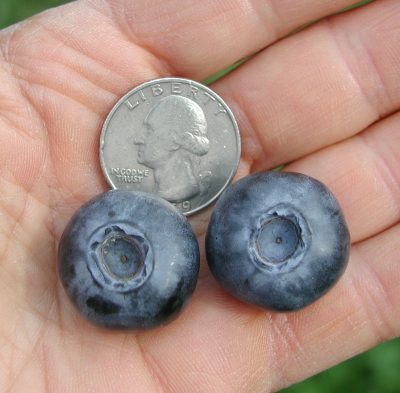
But — and this is important — berries will be both more plentiful and larger if two different varieties cross-pollinate each other. (Apples, in contrast, are self-sterile so, with few exceptions, won’t bear any fruit at all without cross-pollination.)
Benefits of cross-pollination aside, why plant just one variety of blueberry? Different varieties ripen their fruits at different times during the blueberry harvest season. With a good selection of varieties, that season can be very long.
Here on the farmden, the season opens with Duke and Earliblue, both usually ready for picking (in Zone 5) at the end of June. The season moves on, with Blueray, Berkeley, and Bluecrop ripening in July, and Jersey, Toro, and Nelson in August.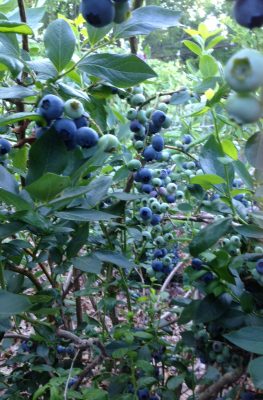 As I write, in September, the variety Elliot is still bearing ripe berries.
As I write, in September, the variety Elliot is still bearing ripe berries.
So if you’re going to plant blueberries, which I highly recommend doing, plant more than one variety, and choose the varieties that let you enjoy berries with your morning cereal or your after dinner ice cream over a long season.
Soil Matters
I pay special attention to the soil when I plant blueberries, and it pays off. Blueberries have rather unique soil requirements among cultivated plants, demanding those that are very acidic, high in organic matter, low in nutrients, and consistently moist and well-aerated. (Most cultivated plants like soils that are only slightly acidic and have moderate to high fertility.) No matter if a soil is not naturally to blueberry’s liking; it can be made so.
The soil where I planted my blueberries drains well. If it did not, I would either choose a better location or else create mounds on which to plant.
Next in importance is soil acidity; I test it before planting. If it’s not at the required pH of 4 to 5.5, I spread pelletized sulfur, a naturally mined mineral, over the ground. (Pelletizing the sulfur makes it less dusty to work with.) 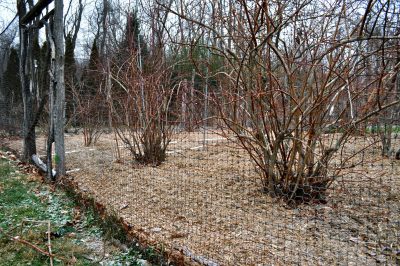
The amount of sulfur, per 100 square feet, needed to lower the pH by one unit would be a pound in a sandy soil and three pounds in a clay soil. My clay loam’s initial pH was about 6.5, so I needed 3 pounds of sulfur per hundred square feet to lower that pH to 5.5, that upper limit enjoyed by blueberries.
Now, for planting. I mix a bucketful of peat moss with the soil in each planting hole and then tuck the plants and soil into the hole, setting the plants slightly deeper than they stood in the nursery. Peat moss is a long-lasting source of organic matter, unique among organic matters in also being low in nutrients.
Right after planting, I spread a 2 to 3 inch depth of some weed-free, fluffy organic material, such as wood shavings, wood chips, straw, pine needles, or autumn leaves, as mulch. The mulch snuffs out weeds, which are more adept than blueberry at soaking up water and nutrients, and keeps the soil cool and moist, just as it is in blueberry’s natural habitats.
With regular watering, as needed, pruning, and annual mulching and attention to soil acidity, blueberry leaves should maintain a healthy, green color, and stems should grow a couple of feet or so each year. My planting of 16 plants yields almost 200 quarts per year of delicious, organic blueberries.
Celeriac Failure, Again
Blueberries have been a great success; now for a failure. Celeriac, a celery relative that puts that flavor into its softball-sized, white root, isn’t well-known as a vegetable, but I’d like to grow it. I’ve tried, for the past couple of years, without success. The problem is some sort of celery blight that kills the top growth so there’s no greenery to feed the root.
Both early blight and late blight, fungal diseases, could cause problems. They arrived in gardens on infected celery seed and/or infected celery debris from the previous cropping season. 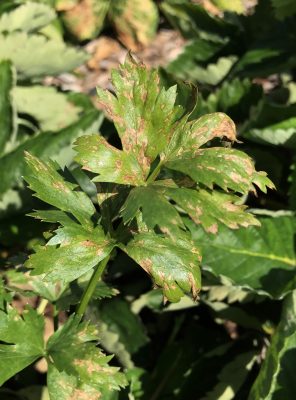 Last fall I thoroughly cleaned up diseased plants, even planted some celeriac this year in the greenhouse. Failure occurred both outdoors and in the greenhouse, although lots of rain and heat could have helped (the fungi or bacteria, not me).
Last fall I thoroughly cleaned up diseased plants, even planted some celeriac this year in the greenhouse. Failure occurred both outdoors and in the greenhouse, although lots of rain and heat could have helped (the fungi or bacteria, not me).
I’m not giving up. Perhaps the seed is the problem. Seed can harbor the disease, but can be “cleaned” up with a heat treatment: 30 minutes at 118°F. As a last resort, I could spray an organic fungicide such as one of the organically approved materials based on copper or hydrogen peroxide. Perhaps this time next year I’ll be eating celeriac.

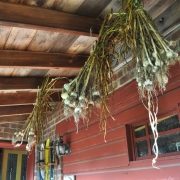
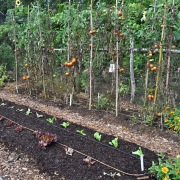

Greetings from Seattle. Thanks for sharing your varieties. I have three, I need to double check but I believe one is early, two are mid season. I would love to extend the season. Blueberries are on sale at my favorite nursery now and hopefully I’ll find a couple to fit the bill. Excellent time to plant in Zone 8. Sorry about the celeriac. It seems like a good alternative to regular celery. I don’t like growing regular celery. All that water and it takes forever to grow.
I grow celery also. Although they taste very similar, their used, texture, and even the slight difference in flavor warrant, for me, growing both. Or, rather, trying to grow both.
Dear Dr. Reich–My three pear trees provided about 50+ pears last year and prior years also. This year one tree had two small thumb size starters- but no other pears on it or from the other two= completely bare. All three had a splendid spread of healthy leaves! But no fruit. Starting last year and on to this year I’ve had no bees or wasps around the house. I know not why. I do not recall seeing any spread of white areas on the trees this year where I presume the Bees pollinate the trees. I’m located across the street from J P’s on the same side as the Cracker Barrel. Always has been a good gardening area.
I don’t know what you mean by the “white areas.”
Lee,
Was wondering what brand of pelletized sulfur you use and where you get it from. Having a hard time finding any at my local garden center.
Also, what time of year is best to apply sulfur around your blueberry bushes?
Thanks,
Matt
I don’t specify a brand. My local garden center also doesn’t ordinarily have it but can order it to be delivered with their shipment of other soil amendments. Timing for application isn’t critical; just the sooner the better if pH change, rather than maintenance, is needed.
Thanks, Lee
The only thing I can find easily is Espoma Acidifier. I read it is 30% sulfur. Looked up the SDS for the product and the balance appears to be bentonite clay and gypsum. Is this something you would use? Or is the pelletized sulfur you use 100% sulfur?
It’s available online, except that shipping charges will be high because it’s heavy. For instance, Fedco sell sulfur that 90% sulfur and 10% bentonite. I wouldn’t buy the Espoma product.